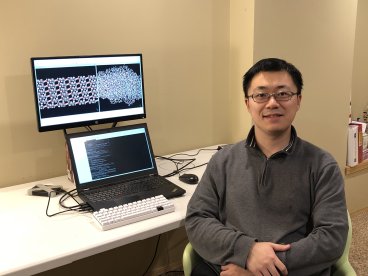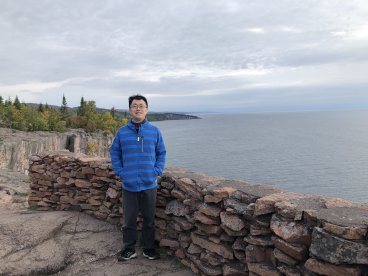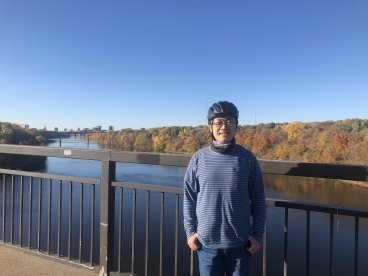Meet CTC: Ziwei Rocky Wang

February 8, 2021 -- Ziwei Rocky Wang is a fifth-year Ph.D. candidate in the Neurock group at the University of Minnesota-Twin Cities in the Department of Chemical Engineering and Materials Science (CEMS). He earned his Bachelor of Science degree in Chemical Engineering from Ohio State University in the summer of 2016.
Rocky studies reactions of renewable feedstocks, including converting lignocellulosic feedstocks to liquid fuels and chemically recycling waste plastics to reduce environmental impacts. To do this, he is developing a kinetic Monte Carlo program that can simulate complex reaction networks of macromolecules in the melt phase with atomic resolution. Currently, the simulation has been applied to study reaction kinetics and product distribution of biomass pyrolysis and plastic pyrolysis. These two processes are the focus of many researchers because currently, they are some of the most accessible ways to transform fuel and chemical production into sustainable processes on a large scale.
In addition to using Gaussian for first principle calculations, he writes his own kinetic Monte Carlo program in a combination of MATLAB and C++. Occasionally, he also uses VASP for molecular geometry optimizations and LAMMPS for classical molecular dynamics simulations.
During his free time, Rocky likes to be outside, regardless of the season. In the summer, he rides his bike on local trails and drives out of the city to go hiking and sightseeing at state parks on the weekends. In the winter, he goes snowshoeing and cross-country skiing on the weekends. He also likes to occasionally plan exciting, adventure-filled road trips with family and friends.

How did you become interested in studying chemistry, and what gets you the most excited about your field?
My interest in chemistry started when I was very young. I was fascinated by cool science experiments, such as elephant toothpaste and soap-powered boat experiments. My interest grew when I realized that chemistry drives technological advancements and it is connected to every aspect of our lives. From developing efficient processes to produce fertilizers, plastics, and other bulk chemicals, to the synthesis of life-saving pharmaceuticals, chemists and chemical engineers have applied their knowledge and skills to better every aspect of human lives and the environment.
The current generation of chemists and chemical engineers are combating climate change by developing and implementing sustainable ways to obtain fuel and chemicals and to reduce carbon emissions. I am excited to be a small part of this effort with my research findings.
Why did you choose the University of Minnesota, and what led you to join your current research group?
I chose to pursue my Ph.D. in the Department of CEMS at UMN because the department is active in high quality and fundamental scientific research, and it’s highly regarded in the community. I was also attracted to its unique interdisciplinary style and collaborative culture.
I joined Professor Matthew Neurock’s group because the group is laser-focused on sustainability in the field of catalysis and reaction engineering. The group is active in many areas, including biomass feedstock conversion, catalytic conversion of biomass-derived platform chemicals, electrocatalytic reduction of CO2, and oxidative coupling of methane. Improvements to these processes will have positive and lasting impacts on the environment, energy production, and the climate.

What is your favorite part about living in the Twin Cities?
I love living in the Twin Cities. There are lots of awesome local small businesses, and I am impressed by the park and bicycle trail systems. There are also countless great events year-round, including the state fair, restaurant week, and winter carnival.
What do you enjoy most about your research? What has been your most interesting or surprising finding so far?
I enjoy my research because I have the opportunity to build a new and unique simulation where the community does not have a lot of established precedence. My research is mentally stimulating and rewarding, and I encounter new problems that require creative problem solving every step of the way.
So far, the kinetic Monte Carlo simulation I developed has been implemented in modeling cellulose pyrolysis reactions. I have shown that my simulation is better at capturing the kinetic features observed in experiments than traditional deterministic models.
What are you most proud of about your academic career so far, and what’s one thing you’d like to achieve in the future?

When I first started my graduate studies, I decided to study pyrolysis reactions of lignocellulosic biomass, an open-ended problem that I, and much of the scientific community, have little prior knowledge of. I am proud that I quickly identified the critical aspects of the challenge and formulated a novel way to tackle the problem that also aligns with my personal interest and my research group’s expertise. Before long, I developed a simulation scheme from scratch. The simulation I developed has been shown to simulate reaction networks of cellulose feedstock with atomic resolution, with success in predicting time-resolved reaction kinetics and product distribution.
In the future, I’d like to expand my simulation to include more reaction pathways to simulate more renewable feedstocks for fuels and chemical productions. I hope to see my simulation results aiding reactor and process design in large scale biorefineries.
What drives you to be a better scientist?
I am driven by the conviction that scientific research has enabled and will continue to enable substantial and transformative progress in improving societal welfare. I am also driven by the opportunity to work among the brightest and most hard-working colleagues, who are pursuing very relevant goals with sustained efforts.
What advice do you have for aspiring scientists?
When faced with a seemingly insurmountable research problem, do not be scared and do not charge blindly into the problem, either. Instead, evaluate the problem thoroughly and lay out clear plans that break the grand mission into small, manageable tasks. Adjust and reevaluate your plan as you tackle pieces of the project.
